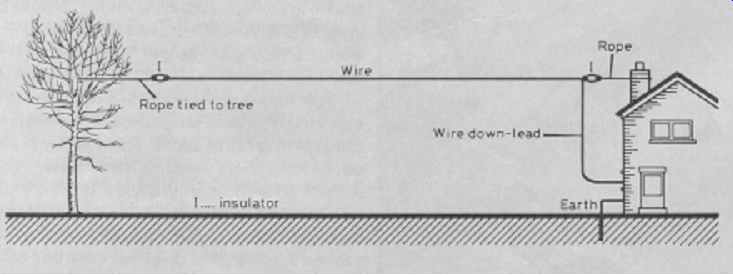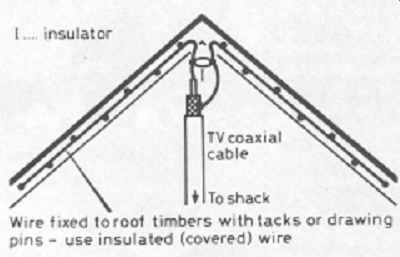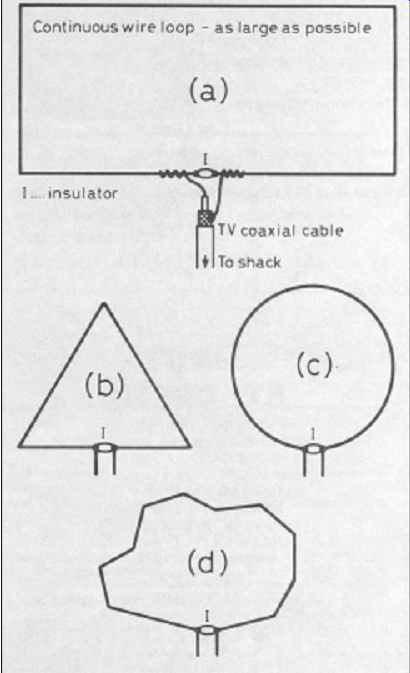AMAZON multi-meters discounts AMAZON oscilloscope discounts
Introduction
For any radio receiver to work well, it must have some form of antenna, or aerial. In almost all domestic transistor radios, the aerial is built into the set, either as a ferrite rod (which looks like a rod of dark grey metal) on which are wound coils of wire, or as a chromium-plated telescopic metal rod. Some radios have both forms of aerial, using the ferrite rod aerial for long waves (LW) and medium waves (MW) and the metal rod for very high frequency (VHF) stations using frequency modulation.
There's broadcast reception . . .
No aerial is perfect, and these two types are far from perfect! As in most mass-produced equipment, they serve their purpose, which is not critical, and they allow the radio to be carried around easily, because they are not big and bulky. The broadcast stations are very powerful, usually quite close, and the circuits in the radio are quite sensitive, so the need for large aerials disappears.
. . . and there's amateur DX
Here we have an application which, in comparison with the broadcast situation, couldn't be much more different. The stations do not use much power, they may be half the world away, and the requirement for good aerials and very sensitive receivers is paramount. The aerials must be large and they must be as high as possible, away from buildings and trees, which cause reduction in signal strength, and away from man-made sources of interference.
You may not have thought about this but, in general, the larger an aerial becomes, the longer the cable (or 'feeder') must be in order to reach your shack and the receiver inside it. Cables reduce the received signal, so what your aerial gains by being large, the feeder (if you're not careful) will lose!

Figure 1 A tree at the bottom of the garden can provide a useful antenna
support. Insulators can usually be obtained from Tandy stores or TV aerial
suppliers.
A simple aerial . . .
We now know that a 'good' aerial is essential. But what is a 'good' aerial? It depends on your purse, your property and your enthusiasm! One of the simplest (and, incidentally, one which is not subject to the cable loss problem discussed above) is the Long Wire, shown in Figure 1. This is, quite literally, a long piece of wire going from a chimney stack to a tree or pole at the end of the garden. The longer it is, the better. Notice that the wire itself is not used to loop around the tree or chimney. Rope is used for both, and is secured to the end of the wire using an insulator of the 'dog bone' or 'egg' variety, to be found in profusion at rallies.
The wire is brought into the house through a window into the shack where the receiver is situated. The long wire aerial is best used with an aerial tuning unit (ATU), which is also described in this guide. One of the advantages of the long wire is that it can be used on several frequency bands.
. . . and more complicated ones
Next up the ladder of complexity is the dipole (meaning two poles, or two elements). One form of dipole for lower frequencies would take the same basic form as the long wire, except that the feed to the receiver is taken, not from the end, but from the center. The wire is essentially cut into two halves, and the two ends at the center are connected to one end of a coaxial cable, which is then taken to the receiver. A smaller form of this is shown in Figure 2, which is conveniently mounted in a house loft. Aerials should always be mounted outside for best results, but will work when mounted inside, and the loft space is the logical situation.
The total length of the dipole should ideally be one-half of the wavelength of operation - hence the term 'half-wave dipole'. For example, a dipole for use on 20m should be about 10m long. Dipoles are thus 'single-band' aerials. They can be modified for use on several bands, and then become known as 'trapped dipoles', having coils and capacitors at certain points along their lengths.

Figure 2 An indoor antenna should be mounted as high as possible.
Indoor aerials
For flat- or apartment-dwellers, an indoor aerial is often the only solution, in which case the dipole of Figure 2 may be of great use. Other popular types include the loop aerial, of which several types are shown in Figure 3.
The shape of the loop is of secondary importance, but it should be as large as possible.

Figure 3 Try different shapes of loop antenna to see which works best.
Ingenuity is called for when considering indoor aerials. A dipole can be mounted along a picture rail or pelmet. A vertical loop of aluminum foil can be stuck to an inside wall and covered with wallpaper! The designs are limited only by your imagination, and will give you hours of listening pleasure
Outdoor aerials
If you want to venture beyond the simple long-wire discussed earlier, then the erection of outdoor aerials can be a bit tricky; they can be more than a one-man job, and can involve seeking planning permission. Get some help advice from someone who has done it before - what about your local radio club? Plenty of designs for aerials appear in RadCom, so you should never be short of ideas!